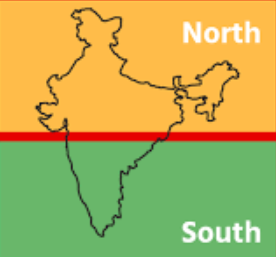Part and Whole: How the South Outpaced North India (GS Paper 3, Economy)

Context
- A new working paper from the Economic Advisory Council to the Prime Minister highlights a significant shift in the economic contributions of Indian states over the last six decades.
- It reveals how southern states have outpaced their northern counterparts, reshaping the country’s growth narrative.
State of States in India’s Growth Story
Uttar Pradesh (UP)
- Historical Contribution: In 1960-61, UP contributed 14.4% to India's GDP. By 1990-91, this share had declined to 12.6%, and subsequent bifurcation has further exacerbated its economic decline.
West Bengal (WB)
- Declining Share: West Bengal’s GDP share dropped from 10.5% to 5.6%, with its per capita income now falling below the national average, a stark contrast to its past prosperity.
Punjab
- Impact of the Green Revolution: Punjab once thrived due to agricultural advancements, with per capita income rising to 169% of the national average in the 1970s. However, its GDP share has plummeted from 4.4% in 1970-71 to 2.4% in 2023-24.
Post-1991 Economic Landscape
The economic reforms of 1991 opened up opportunities, allowing southern states to capitalize on new growth avenues:
- Significant Contribution: By 2023-24, the five southern states accounted for approximately 30% of India’s GDP.
- Manufacturing and Services: Southern and western states, particularly Gujarat and Maharashtra, have thrived in manufacturing and services, including a concentration of IT firms in the south.
- Export Hubs: Major exporting districts are predominantly found in these regions, further boosting their economic profiles.
Share in Taxes
As southern states have surged ahead economically, their share in the divisible tax pool has declined:
- Tax Share Decline: Their share fell from 21.1% during the 11th Finance Commission (2000-2005) to 15.8% in the current period (2021-2026).
- Revenue Dependence in Lower-Income States: In contrast, states like UP, Bihar, and West Bengal rely heavily on central transfers, which constitute a significant portion of their revenue.
Concerns of the Southern States
The economic advancements have not come without challenges:
- Fiscal Resource Distribution: The changing dynamics in tax revenue allocation raise concerns about equity and fairness in resource distribution.
- Political Representation: Structural changes in the Lok Sabha due to delimitation could result in southern states receiving a reduced share of parliamentary seats, impacting their influence in national politics.
Way Forward
- To maintain the balance and functionality of India's federal system, it is crucial for policymakers to engage in wise and forward-thinking governance.
- Addressing these challenges is vital to ensure equitable growth and representation across states, safeguarding the collaborative spirit that underpins India’s democracy.
In conclusion, the shift in economic performance highlights a pressing need for dialogue and action to ensure that all regions can thrive without compromising the integrity of the federal structure.


